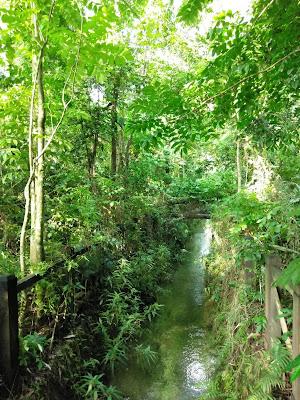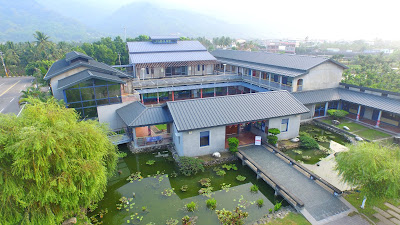Yellow Butterfly Valley and Meinong Yellow Butterfly Festival
Not only rich in Hakka culture, Meinong is but also well-known for its abundant ecological resource in Yellow Butterfly Valley (黃蝶翠谷) and a social movement aroused to protect the environment in the valley in 90's. Meinong Yellow Butterfly Festival (美濃黃蝶祭) was the reaction of the successful movement and nowadays has become one of the representative events in Meinong.
 |
| The trail inside Yellow Butterfly Valley |
 |
| The signage introduces the tree |
The valley gathered numerous butterflies started from Japanese era as well. Japanese government intended to produce gun buttstocks and railway ties to support frontline, planting plenty of Kassod tree (Cassia siamea) that is the food plant of yellow emigrant butterfly (Catopsilia Pomona) so the name has been given.
 |
| One species of butterflies observed in the valley |
Anti-Dam Movement and the eco-oriented festival
In 90's, the ruling party KMT planned to build up a dam in Meinong, right situated in the valley, to solve the problem of water shortage in the south. The construction proposal was overwhelmingly objected among locals for some reasons. The first concern was the safety of the dam. The expected dam site, distant with nearby villages by hundreds of meters, is exactly in earthquake zones. The second one was the comprehensive ecosystem in the valley would be destroyed. Moreover, the campaign was connecting with international trends of opposing to dam building and revealed progressive statements that made the whole movement more persuasive.
Opposition activities were taken place in various ways. In addition to the protests in front of the Legislative Yuan, the dominated community Meinong People's Association (MPA, 美濃愛鄉協進會) conveyed the idea against the dam by arranging Meinong Yellow Butterfly Festival in the valley since 1995, announcing to the world the reasons against the dam and internalising the concept of protection of natural resources to the local residents.
As the then new-elected President Chen declared no Meinong dam in his term, the anti-dam movement has gained temporary victory in 2000. Without the threat of the dam, the MPA keeps conducting community development in the rural village while Meinong Yellow Butterfly Festival has transformed into a local ecological and educational carnival, not only awakening people's awareness toward the variety of species in this land, but also internally empowering volunteers, ranging from kindergarten children to adults, from locals to nonnatives, to participate in the bottom-up event.
The festival is composed of the main ceremony and a series of events. The ceremony of worshipping the God and the lives in the valley is based on the Hakka etiquettes and the belief in the Land God (土地公,伯公). Dressed in Hakka blue shirt, the priests of the ceremony who are usually the prestigious residents and politicians first head to the Land God of Yellow Butterfly, appreciating them blessing the land and its people. Then, the children, representing the future host, announce the elegy to express human's apology of ruining the habitat of yellow butterflies and other lives, and the resolution of preserving the homeland.
A varied of events, designed depending on the topic of that year, shows creativity and diversity in this vibrant community. For example, in 2017, the 21st festival emphasised on two themes. The six small and delicate exhibitions distributed in different corners in Meinong respond the first topic: the youth who returns to the village. With divergent backgrounds and skills, the six curators showcase their ideas related to the land. The other topic "Attempt the idea of Satoyama" initiate agricultural experiential trips that introduce eco-friendly farms and their crops in season to the public. Moreover, there are other events including films from Wildscreen broadcasting in the village, hiking along ancient paths, Hakka concert from the hottest Sheng-Xiang & Band, and unofficial local coming of age - gliding through the water bridge.
 |
| The farmer explains his sesame in the agricultural experiential trip |
The festival has transformed from annual to biennale since 2015. The main ceremony of the 21st has ended in July 2017 while some relevant events are still ongoing in August. The 22nd will be held in summer in 2019.



Comments
Post a Comment